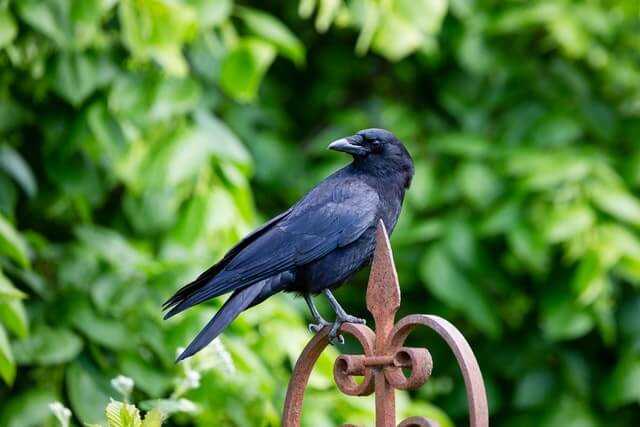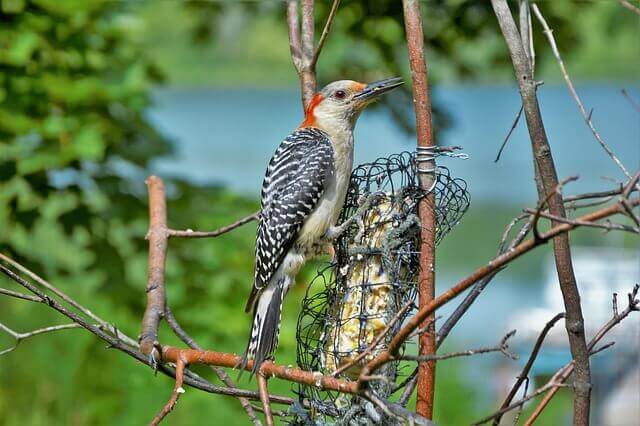Embark on a comprehensive exploration of Nebraska’s avian diversity with our ultimate guide featuring the 66 most common bird species! From the majestic Bald Eagle to the charming American Goldfinch, Nebraska’s landscapes host a rich tapestry of birdlife.
In this comprehensive guide, we’ll uncover the unique characteristics, habitats, and behaviors of each species, offering valuable insights for bird enthusiasts and nature lovers.
Table of Contents
- 1 Most Common Birds in Nebraska
- 1.1 American Robin
- 1.2 Mourning Dove
- 1.3 Northern Cardinal
- 1.4 Blue Jay
- 1.5 European Starling
- 1.6 Red-winged Blackbird
- 1.7 American Goldfinch
- 1.8 House Sparrow
- 1.9 Common Grackle
- 1.10 Downy Woodpecker
- 1.11 Northern Flicker
- 1.12 Dark-eyed Junco
- 1.13 House Finch
- 1.14 White-breasted Nuthatch
- 1.15 Black-capped Chickadee
- 1.16 Western Meadowlark
- 1.17 American Crow
- 1.18 Red-bellied Woodpecker
- 1.19 Eurasian Collared-Dove
- 2 Author
Most Common Birds in Nebraska
American Robin
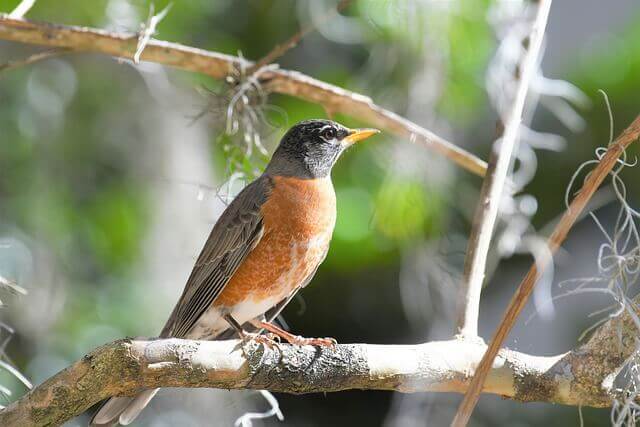
American Robins are common in many parts of the United States. This is a bird that is often seen near homes and yards, fields and other iopen spaces, as they prefer to eat insects such as flies, spiders, grasshoppers, crickets, and caterpillars from lawns and other areas where there may be water sources nearby.
American Robins are migratory birds, and are one of the few bird species to return north during winter months for their annual migration.
- Frequency: 50.89% (Statistic by: eBird)
- Color: Mostly brown on the back with an orange-colored breast, yellow bill
- Habitat: Wooded areas, backyards, parks, fields
- Range: USA, Canada, Mexico
- Size: 12 – 16″ inches in length
- Weight: 72 – 95 grams
- Diet: Fruits, berries, and insects (earthworms, beetles, caterpillars etc.)
- Maps: Range Map – Sightings Map
- Sounds: Calls and songs
- Family: Turdidae
- Genus: Turdus
Related Post: Interesting American Robin Fun Facts
Mourning Dove
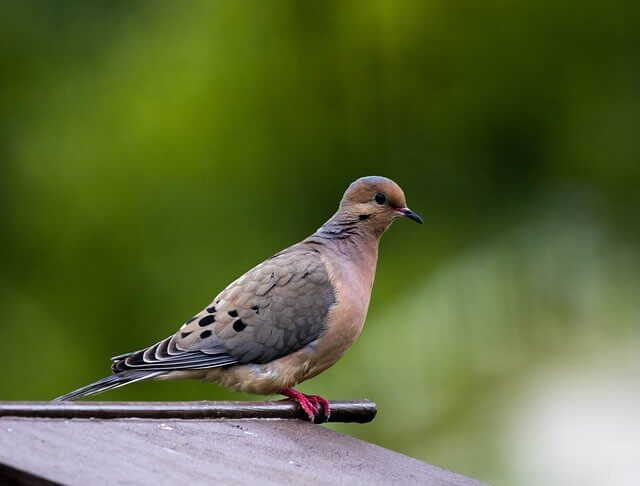
The Mourning Dove is one of the most common birds in North America. It can be found all over the continent, from Canada to Mexico and east to Ohio. Mourning doves are often found in residential areas and gardens.
The species has adapted well to living alongside humans, often nesting on roofs or other structures that are near people’s homes. They usually feed on seeds, fruit, insects, worms, and other small invertebrates. They typically eat about three times their body weight each day.
- Frequency: 38.60%
- Color: Light gray-brown and lighter and pinkish below. The wings have black spots, small dark bill.
- Habitat: Open habitats, urban areas, farms, prairie, grassland, wooded area
- Range: USA, Canada, Mexico, Central America, Greater Antilles
- Size: 12″ inches length
- Weight: 112 – 170 grams
- Diet: Rapeseed, corn, millet, safflower, sunflower seeds, pokeberry, sesame, and wheat.
- Family: Columbidae
- Genus: Zenaida
Related Posts: 10 Facts about Mourning Doves
Northern Cardinal
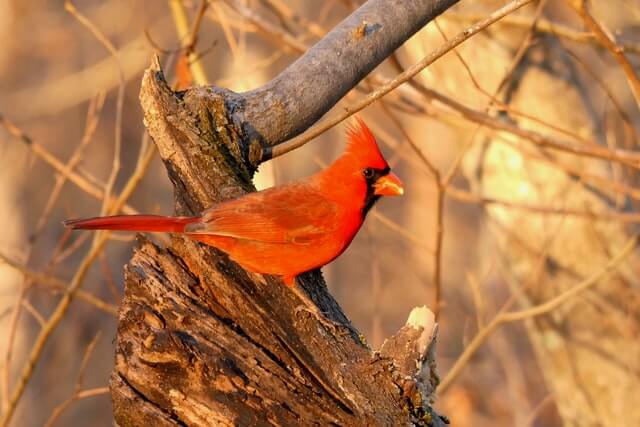
The Northern Cardinal is a common bird that lives in the Eastern United States. It can be found in both rural and urban areas but prefers to live near shrubs or thickets. Cardinals are most active during the day and usually feed on seeds, fruits, berries, insects, and other small animals.
Northern cardinals have two distinct vocalizations: an aggressive song sung by males from high perches during the breeding season, and a low crooning call given by females when they want to nest or mate.
- Frequency: 36.90%
- Color: Mostly red throughout, with a black mask on the face
- Habitat: woodlands, gardens, parks, backyards, and wetlands
- Range: USA, Canada, Mexico
- Size: 8.2 – 9.3″ inches
- Weight: 33 – 65 grams
- Diet: Fruits, berries, and insects (grasshoppers, beetles, snails, cicadas)
- Family: Cardinalidae
- Genus: Cardinalis
Related: Where are Cardinal Birds Found – Best Places to Look
Blue Jay
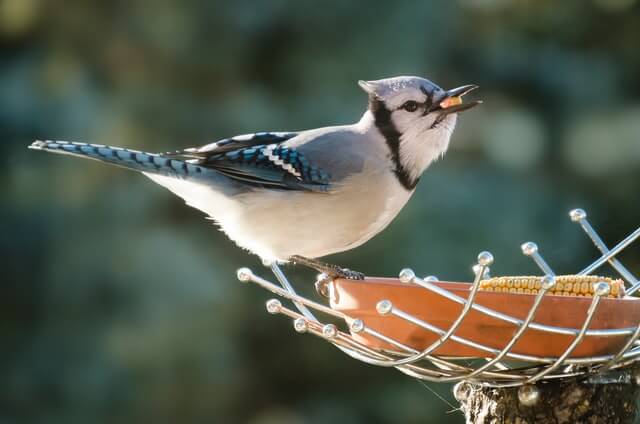
The Blue Jay is a beautiful bird that we have come to love and enjoy. They are known for their gorgeous blue feathers, beady black eyes, and the way they like to sit on branches in trees. Blue Jays are birds of the Corvidae family. They are members of the passerine order, along with jays and crows.
Blue Jays feed on a variety of food sources such as insects, fruits, nuts, and seeds. They can be found in forests or suburbs in North America where they tend to stay near water sources.
- Frequency: 35.49%
- Color: Blue crest on the head, wings, back, and tail, and has a white face and belly
- Habitat: Deciduous and mixed forests, mixed woodlands, backyards, parks
- Range: Southern Canada, Eastern and Central United States, Florida and Texas
- Size: 8 – 12″ inches
- Weight: 70 – 100 grams
- Diet: Nuts, seeds, caterpillars, grasshoppers, and beetles
- Family: Corvidae
- Genus: Cyanocitta
Related: How to Attract Blue Jays to your Yard?
European Starling
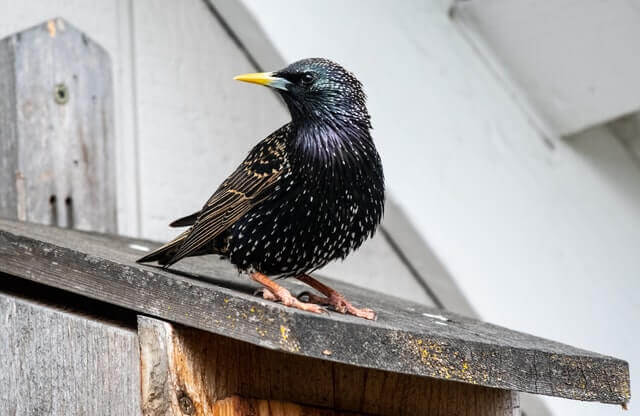
The European Starling is native to Europe and Asia but has since migrated to North America as well. They are usually found around farms, fields, and parks. The males of the species have glossy black plumage with iridescent bronze-green and purple feathers on their wings.
Females are browner than males but also possess bright patches of reds, yellows, and blues. This coloration attracts mates during mating season which occurs in late winter to early spring when they will produce two or three broods per year.
- Frequency: 34.43%
- Color: Black with glossy green and purple iridescence plumage, yellow beak.
- Habitat: Forests, woodlands, backyards, edges, yards, and parks
- Range: North America, Europe, Africa, India, China, Middle East.
- Size: 7 – 9″ inches long
- Weight: 60 – 100 grams
- Diet: Insects (ants, beetles, invertebrates), fruits, seeds, berries
- Family: Picidae
- Genus: Colaptes
Related Posts: How To Attract European Starlings To Your Yard Fast?
Red-winged Blackbird
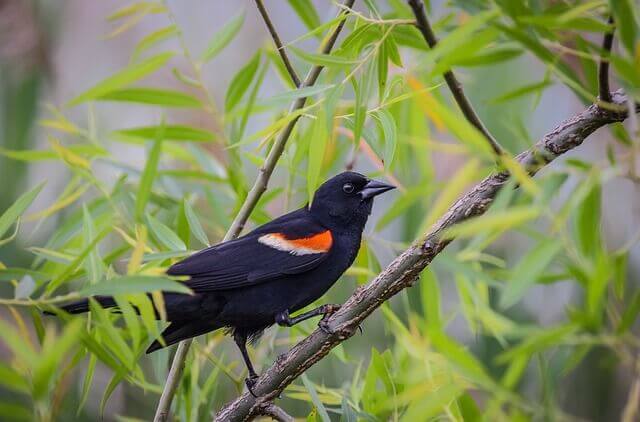
The Red-winged Blackbird is a type of bird that is commonly found in North America. It has a black body with two red wing feathers and can be seen in many habitats such as farmland, marshes, ponds, creeks, wetlands, and parks.
It eats seeds, and insects during the summer months while living off the food it collected during winter months when there are not many plants to eat. The Red-winged Blackbird nests during April or May, laying three eggs per clutch on average.
- Frequency: 32.97%
- Color: All black with red patches on shoulder and a yellow wing bar
- Habitat: Deciduous forests, conifers, roadside, rivers, backyards, parks
- Range: North America, Central America
- Size: 6.7 – 7.1″ inches length
- Weight: 41.5 – 65 grams
- Diet: Seeds and insects (butterflies, dragonflies, moths, frogs, worms, spiders, snails, carrion, flies, etc.)
- Family: Icteridae
- Genus: Agelaius
American Goldfinch

The American Goldfinch is a small songbird native to North America. It’s most common during migration periods, between November and March when it travels south for the winter months. They are often found near gardens, fields, open meadows, and wetlands.
It prefers to eat seeds from the sunflower family, thistle, and coneflower plants. It will also feed on fruits and berries when available. In winter it feeds mainly on weed seeds such as dandelion or milkweed pods.
- Frequency: 31.59%
- Color: Face, neck, and underside are yellow, black wings with white bars
- Habitat: Deciduous conifers, and forests, thickets, gardens, roadside, grasslands, meadows
- Range: Canada, USA, and Mexico
- Size: 4.3 – 5.5″ inches length
- Weight: 12 -18 grams
- Diet: Grass, dandelions, chickweed, sunflowers and ragweed, thistle, red alder, birch, spruce seeds
- Family: Carduelinae
- Genus: Spinus
Related Post: American Goldfinch Interesting Facts
House Sparrow
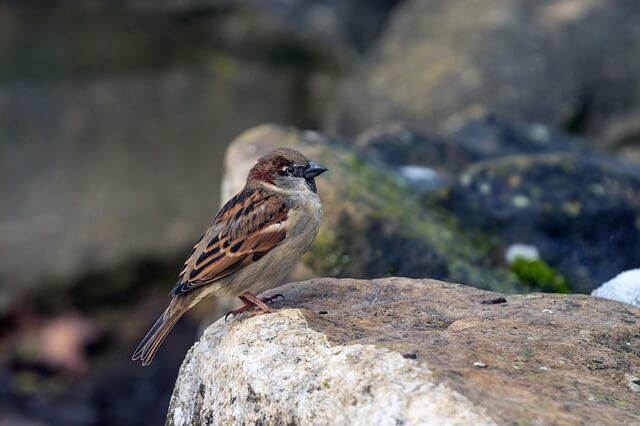
House sparrows are common in many parts of the world. These birds can be found on every continent except Antarctica and they are one of the most widely distributed species. House sparrows tend to live in open spaces, often foraging on the ground for food and nesting in nearby structures like bushes or trees.
Their nests, or breeding sites, are usually on man-made structures such as bridges and houses. They also nest in tree cavities and crevices in rock faces.
- Frequency: 30.02%
- Color: Gray head marking, a reddish-brown back, and gray underparts
- Habitat: Urban centers, Rural, suburban areas, gardens, edges, and parks
- Range: North America, Central America, South America, Africa, Australia, New Zealand
- Size: 5.5 – 7.1″ inches in length
- Weight: 25 – 39 grams
- Diet: Insects, beetles, caterpillars, aphids,, grasshoppers, crustaceans, earthworms, vertebrates
- Family: Passeridea
- Genus: Passer
Related Post: How to Attract Sparrows to your Backyard
Common Grackle
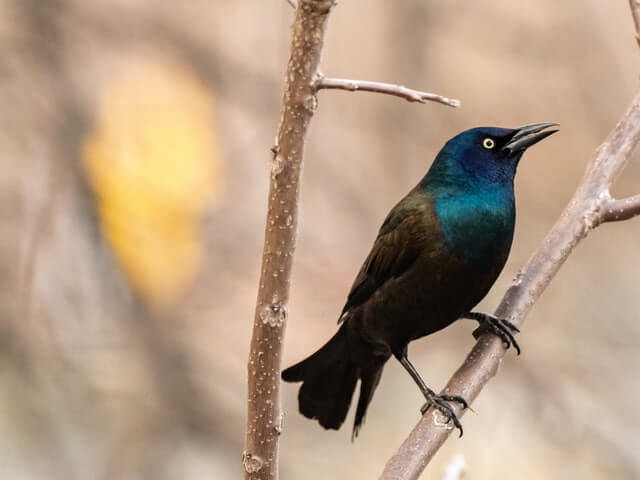
The Common Grackle is a large blackbird that breeds in the eastern United States and southern Canada. They live on farmland, marshes, forest edges, orchards, gardens, and urban areas where they can find food on sidewalks, parking lots, lawns, and parks.
Common Grackles feed on insects, worms, snails, berries, and other fruits as well as grains. These birds typically nest in tree cavities or fence posts near water sources such as rivers or creeks but will also use man-made structures like bridges or buildings to house their young.
- Frequency: 28.22%
- Color: Black overall with a blue, and purple iridescence.
- Habitat: Woodlands, marshes, meadows, parks, backyards, and fields
- Range: East of the Canadian Rockies, Canada, and the United States
- Size: 11 – 13″ inches length
- Weight: 75 – 143 grams
- Diet: minnows, eggs, berries, seeds, grain, insects, frogs, mice
- Family: Icteridae
- Genus: Quiscalus
Downy Woodpecker
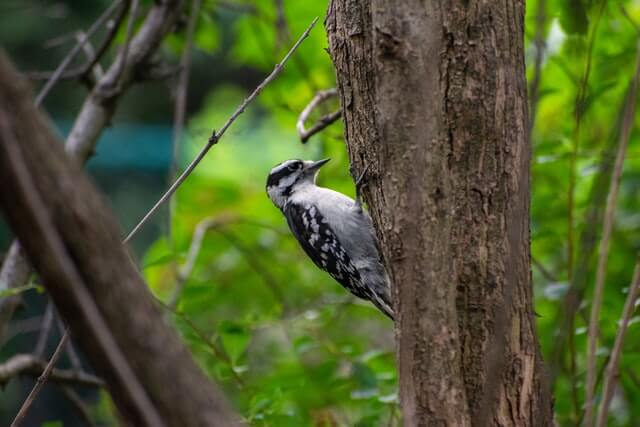
The Downy Woodpecker is a small bird that lives year-round in North America. The average size for this bird is 5.5 to 7.1″ inches tall, with a wingspan of 10 to 12″ inches. The diet of the Downy Woodpecker consists mainly of insects but they also eat fruits, nuts, seeds, berries, and eggs from other birds’ nests.
They live in forests or parks where there are trees to nest in or near water for food sources such as streams or ponds.
- Frequency: 26.02%
- Color: Black with a white throat, belly, and back. White spots on wings
- Habitat: Deciduous forests and thickets, roadside, grasslands, backyards, parks
- Range: Canada, USA, and Mexico
- Size: 5.5 – 7.1″ inches in length
- Weight: 20 – 33 grams
- Diet: East mostly insects such as ants, beetles, gall wasps, and caterpillars
- Family: Picidae
- Genus: Dryobates
Related Posts: How to Attract Downy Woodpeckers: Expert Tips!
Northern Flicker
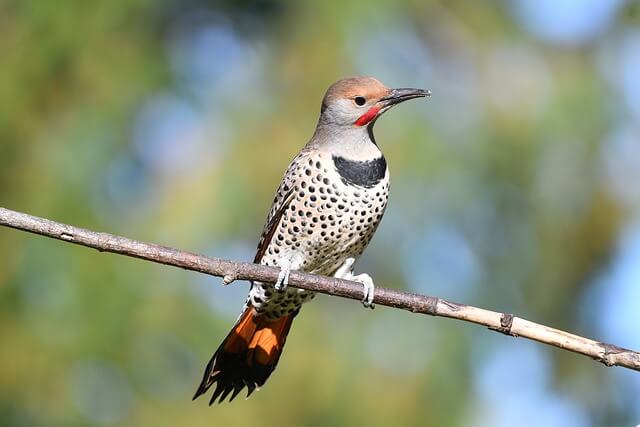
Northern Flickers are a species of woodpeckers that is native to North America. They like to live in forested areas, but will also come into towns or cities if there are trees.They have an average length of about 11 inches and weigh about 4 ounces.
The flicker’s diet consists mainly of insects, but they will also eat other invertebrates such as worms and larvae. The Northern Flicker is often seen on the ground looking for food or nesting material, unlike most other woodpeckers which spend their time in trees.
- Frequency: 25.46%
- Color: Light brown plumage throughout with black bars across back, chest, wings, belly
- Habitat: Forests, woodlands, backyards, edges, yards, and parks
- Range: North America, Central America, Cuba, Cayman Islands
- Size: 10 – 14″ inches
- Weight: 85 – 165 grams
- Diet: Insects (ants, beetles, invertebrates), fruits, seeds, berries
- Family: Picidae
- Genus: Colaptes
Related Post: How to Attract Northern Flickers to your Backyard
Dark-eyed Junco
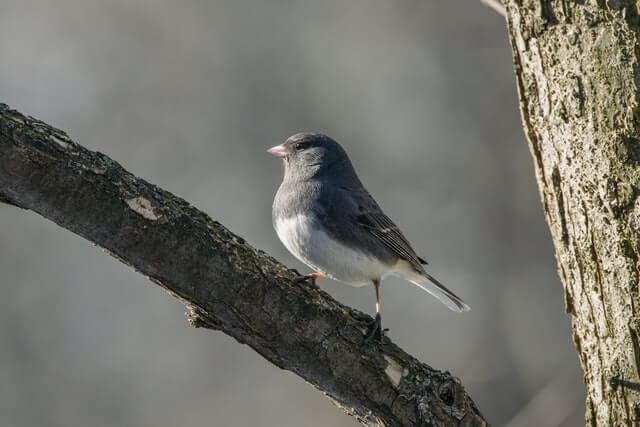
The Dark-Eyed Junco is a small, grayish ground-dwelling bird that typically inhabits deciduous forests throughout North America. Its diet consists mostly of seeds from grasses, weeds, cereal grains, fruits, and berries, with occasional insects for extra protein.
The Dark-eyed junco is monogamous which means that it mates for life and only breeds once per year. They are highly social birds as they often feed together and even help their mates incubate eggs during the breeding season.
- Frequency: 25.27%
- Color: Gray head, neck, breast, gray/brown backs and wings, white underside
- Habitat: Wooded areas, forest edges, roadsides, gardens, parks.
- Range: USA and Canada
- Size: 5.1 – 6.9″ inches
- Weight: 18 – 30 grams
- Diet: Seeds, insects, and arthropods
- Family: Passeriformes
- Genus: Junco
Related Post: Interesting Dark-eyed Junco Fun Facts
House Finch
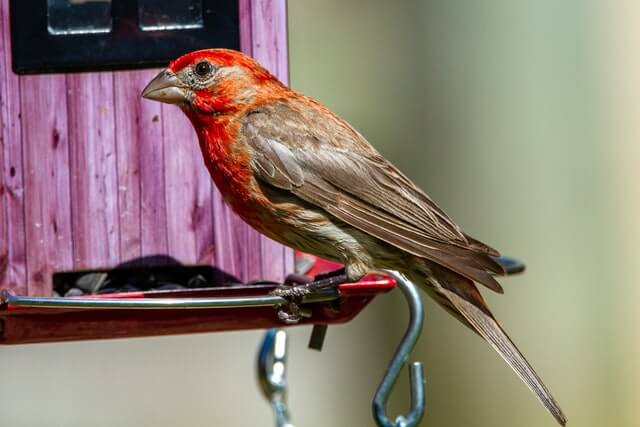
The House Finch is a small bird found throughout the United States and Canada. They can be found anywhere from east of the Rocky Mountains to as far west as California and Mexico. They prefer to live near human habitation because they thrive on our waste products such as grains, bread crumbs, spilled seed, fruit, and other food items.
Their diet consists of insects, seeds, fruits, berries, and nectar from flowers. They typically make their nests in small cavities or tunnels within pine trees, where they build their nest using plant fibers or hair for insulation.
- Frequency: 23.27%
- Color: Has a reddish face and upper breast, brown streaks on the belly, back, and tail.
- Habitat: urban and suburban areas, backyards, edges, yards, and parks
- Range: Canada, USA, Mexico
- Size: 5 – 6″ inches
- Weight: 16 – 27 grams
- Diet: Aphids, grains, seeds, berries, nettle, dandelion, sunflower
- Family: Fringillidae
- Genus: Haemorhous
Related Post: How to Attract House Finch to your Yard
White-breasted Nuthatch

The White-breasted Nuthatch is a species of nuthatch found in the eastern United States and southern Canada. They live in deciduous forests, pine plantations, and orchards where they forage on the ground among fallen leaves.
White-breasted Nuthatches are omnivores that eat insects, nuts, seeds, and berries from coniferous trees. Nests for these birds can be found in holes in dead or dying tree trunks, as well as tree cavities.
- Frequency: 20.44%
- Color: A white face, flanks, and chest. It has a black cap on its head a bluish-gray upper and a brown lower belly
- Habitat: Deciduous forests, conifers, roadside, rivers, backyards, parks
- Range: Southern Canada, USA
- Size: 5.9″ inches in length
- Weight: 20 grams
- Diet: Acorn nuts, hickory nuts, ants, caterpillars, scale insects, pine weevils
- Family: Sittidae
- Genus: Sitta
Related Post: How to Attract Nuthatches to your Backyard?
Black-capped Chickadee
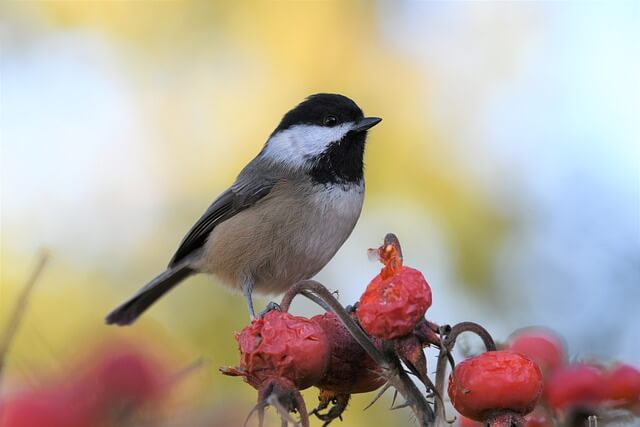
The Black-capped Chickadee is a small, nonmigratory bird common in North America. They live in large groups and have territories of up to 3 square miles. The Black-capped Chickadee lives mostly in the boreal forest, but can also be found in urban areas such as parks and gardens.
It feeds on insects during the summer months, and seeds and berries during winter. During the breeding season (late March through July), they are territorial over their nesting area and may chase other birds, such as House Sparrows.
- Frequency: 19.99%
- Color: A black cap, white on face, white/reddish-brown flanks
- Habitat: Deciduous and mixed forests, backyards, parks
- Range: USA and Canada
- Size: 11.5 -16 cm length
- Weight: 8 – 15 grams
- Diet: Insects, seeds, berries
- Family: Paridae
- Genus: Poecile
Related Post: How Do I Attract Chickadees To My Yard?
Western Meadowlark

Western Meadowlarks are a common sight on the prairies. They have a beautiful song that sounds like ‘cheer, cheer, cheer’. The Western Meadowlark is known for its distinctive orange-yellow breast and cheery song. This bird’s habitats include grasslands across North America from Canada to Mexico.
The Western Meadowlark eats insects, berries, seeds, and sometimes eggs from other birds’ nests. If you want to attract this bird to your yard or garden, put out some native plants for them to feed on like milkweed, thistle, and chicory flowers.
- Frequency: 19.91%
- Color: Mostly brown upper with black streaks and yellow underparts
- Habitat: Pastures, prairies, grasslands, and fields,
- Range: Western and central North America
- Size: 8.5″ inches in length
- Weight: 90 – 115 grams
- Diet: Bugs, seeds, berries
- Family: Icteridae
- Genus: Sturnella
Related: Western Meadowlark Bird Facts You Didn’t Know
American Crow
American Crow is a common bird that is found in almost every region of North America and often makes its homes in rural, and urban areas. They can be identified by their black feathers and glossy appearance, as well as a distinctive call that sounds like “caw.”
Crows typically mate for life, but they will also switch partners if one dies or leaves them. It’s common to see two crows fly together and then land on a perch before flying off again. Their diet consists of insects, small animals, fruit, and seeds that they find on the ground or steal from other birds.
- Frequency: 19.29%
- Color: Black
- Habitat: Open country, farms, parks, woodlands, towns, cities
- Range: Canada, USA, Mexico
- Size: 16 – 21″ inches in length
- Weight: 315 -620 grams
- Diet: invertebrates, carrion, seeds, eggs fish, grains, mice, frogs, and other small animals.
- Family: Corvidae
- Genus: Corvis
Related Posts: How To Attract Crows To Your Backyard: Expert Tips!
Red-bellied Woodpecker
The Red-bellied Woodpecker is a common bird that lives in eastern North America and usually nests in cavities on trees from Maine to Florida and west to Texas. They live near orchards, fields, backyards, and open woodland.
These birds are small but fierce; they will eat bugs and tree sap if necessary. However, most of their diet consists of insects like ants and beetles. Their habitat includes wooded areas, shrubs, and trees in urban environments.
- Frequency: 19.17%
- Color: Gray on body and face and underparts. Black and white pattern on wings, back, and tail.
- Habitat: Forests, backyards
- Range: Southern Canada, Eastern United States, Florida
- Size: 9 – 10.6″ inches long
- Weight: 56 -91 grams
- Diet: Insects, small fish, oozing sap, tree frogs, and eggs of small birds.
- Family: Picidae
- Genus: Melanerpes
Related: How to Attract Red-bellied Woodpeckers to your Yard?
Eurasian Collared-Dove
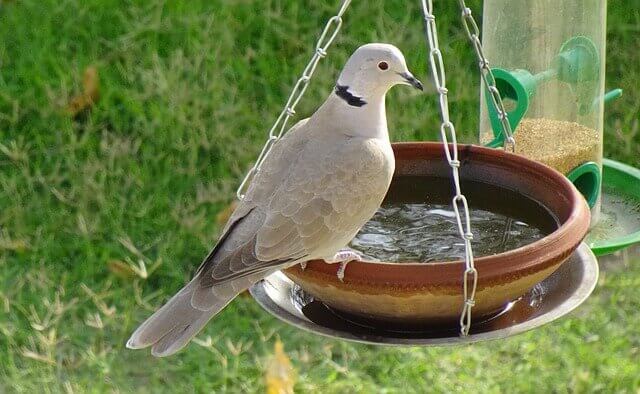
The Eurasian Collared-Dove is a recent invasive species to North America. Originally native to Asia, the Eurasian Collared Dove has no natural predators in North America and can reproduce year-round with three broods per year. They have an extremely large range, from southern Canada all the way down into South America.
The Eurasian Collared-Dove poses a major threat to many of our other birds due to their competitive abilities for food and nesting sites. They feed on insects and seeds from plants, but also eat agricultural crops like corn or wheat. They can damage trees by pecking holes in them to get at grubs inside the bark.
- Frequency: 17.93%
- Color: Pinkish-gray plumage with a black half-collar bar, with white on its neck
- Habitat: Urban centers, farms, backyards, edges, yards, and parks
- Range: North America, Central America, South America, Europe, Asia
- Size: 13″ inches
- Weight: 150 grams
- Diet: Millet, milo, sunflower, wheat, corn, and berries
- Family: Columbidae
- Genus: Streptopelia
Related Post: Facts About Mourning Doves – 10 Things You Need To Know!
Most Common Birds in Nebraska below 17% Frequency of Occurrence.
- Brown-headed Cowbird 16.69%
- House Wren 15.86%
- Turkey Vulture 14.22%
- Eastern Kingbird 12.89%
- Chipping Sparrow 12.78%
- Great Blue Heron 12.58%
- Song Sparrow 11.84%
- Blue-winged Teal 11.74%
- Baltimore Oriole 11.60%
- Rock Pigeon 11.08%
- Brown Thrasher 10.45%
- Eastern Bluebird 10.13%
- Ring-billed Gull 10.02%
- Northern Shoveler 9.65%
- Yellow Warbler 9.63%
- American Kestrel 9.51%
- Red-headed Woodpecker 9.29%
- Bald Eagle 9.18%
- Ring-necked Pheasant 9.13%
- Gray Catbird 8.90%
- American Coot 8.84%
- Dickcissel8.83%
- Wild Turkey 8.32%
- American Tree Sparrow 8.18%
- Wood Duck 8.11%
- Hairy Woodpecker 7.85%
- Common Yellowthroat 7.80%
- Belted Kingfisher 7.69%
- Western Kingbird 7.62%
- Orchard Oriole 7.54%
- Cedar Waxwing 7.53%
- Harris’s Sparrow 7.26%
- Horned Lark 7.14%
- Double-crested Cormorant 7.08%
- Yellow-rumped Warbler 6.97%
- Warbling Vireo 6.95%
- Cliff Swallow 6.87%
- Gadwall 6.85%
- Tree Swallow 6.70%
- Field Sparrow 6.51%
- Pied-billed Grebe 6.48%
- Chimney Swift 6.40%
- Green-winged Teal 6.23%
- Lark Sparrow 6.12%
- Eastern Phoebe 5.52%
- Lesser Scaup 5.19%
- Northern Bobwhite 5.00%


